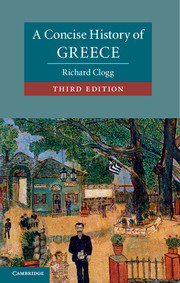Book contents
- Frontmatter
- Dedication
- Contents
- List of Illustrations
- Preface
- 1 Introduction
- 2 Ottoman rule and the emergence of the Greek state 1770–1831
- 3 Nation building, the ‘Great Idea’ and National Schism 1831–1922
- 4 Catastrophe and occupation and their consequences 1923–49
- 5 The legacy of the civil war 1950–74
- 6 The consolidation of democracy and the populist decade 1974–90
- 7 Balkan turmoil and political modernisation: Greece in the 1990s
- 8 Greece in the new Millennium: from affluence to austerity
- Biographies
- The Royal Houses of Greece
- Presidents
- Tables
- Key Dates
- Guide To Further Reading
- Index
4 - Catastrophe and occupation and their consequences 1923–49
Published online by Cambridge University Press: 05 June 2014
- Frontmatter
- Dedication
- Contents
- List of Illustrations
- Preface
- 1 Introduction
- 2 Ottoman rule and the emergence of the Greek state 1770–1831
- 3 Nation building, the ‘Great Idea’ and National Schism 1831–1922
- 4 Catastrophe and occupation and their consequences 1923–49
- 5 The legacy of the civil war 1950–74
- 6 The consolidation of democracy and the populist decade 1974–90
- 7 Balkan turmoil and political modernisation: Greece in the 1990s
- 8 Greece in the new Millennium: from affluence to austerity
- Biographies
- The Royal Houses of Greece
- Presidents
- Tables
- Key Dates
- Guide To Further Reading
- Index
Summary
The chaotic rout of the Greek forces in Asia Minor at the hands of the Turkish nationalists under Mustafa Kemal (Atatürk) signalled the collapse of the ‘Great Idea’ and an ignominious end to Greece’s ‘civilising mission’ in the Near East. As the demoralised remnants of the Greek armies, beset by tens of thousands of panic-stricken and destitute refugees, flooded the Aegean islands and the mainland, a group of Venizelist officers seized power. At their head was Colonel Nikolaos Plastiras, who was to remain a major player on the political scene until the 1950s. King Constantine abdicated, briefly to be replaced by his eldest son, who reigned as King George II. A new civilian government was installed but there could be no doubt that effective power lay in the hands of the revolutionary committee. The army, indeed, was to be a critical factor in the political life of the country throughout the inter-war period.
The bitterness and chaos of defeat were compounded by the feeling that Greece had been abandoned in her hour of greatest need by traditional friends. It was perhaps inevitable that there should also be a hunt for domestic scapegoats. Eight politicians and soldiers, including the military commander in Asia Minor, General Hadzianestis, were court-martialled on charges of high treason, although it was clear that there had been no deliberate treachery. This judicial charade culminated in the execution by firing squad of six of the accused. These included Hadzianestis, who had showed signs of being mentally unbalanced, and Dimitrios Gounaris, the former prime minister, who was so ill with typhus that he had to be helped to the place of execution. The ‘Trial of the Six’, stoking up as it did the already venomous feud between supporters and opponents of Venizelos, was to poison the political climate of the inter-war period.
- Type
- Chapter
- Information
- A Concise History of Greece , pp. 98 - 141Publisher: Cambridge University PressPrint publication year: 2013

